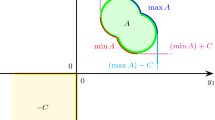Abstract
We study qualitative indications for d.c. representations of closed sets in and functions on Hilbert spaces. The first indication is an index of nonconvexity which can be regarded as a measure for the degree of nonconvexity. We show that a closed set is weakly closed if this indication is finite. Using this result we can prove the solvability of nonconvex minimization problems. By duality a minimization problem on a feasible set in which this indication is low, can be reduced to a quasi-concave minimization over a convex set in a low-dimensional space. The second indication is the separability which can be incorporated in solving dual problems. Both the index of nonconvexity and the separability can be characteristics to “good” d.c. representations. For practical computation we present a notion of clouds which enables us to obtain a good d.c. representation for a class of nonconvex sets. Using a generalized Caratheodory’s theorem we present various applications of clouds.
Similar content being viewed by others
References
E. Asplund, Differentiability of the metric projection in finite dimensional Euclidean space.Proc. Amer. Math. Soc. 38 (1973) 218–219.
J.-P. Aubin and I. Ekeland, Estimates of the duality gap in nonconvex optimization.Math. Oper. Res. 1 (1976) 225–245.
E. Balas, J.M. Tama and J. Tind, Sequential convexification in reverse convex and disjunctive programming.Math. Prog. 44 (1989) 337–350.
B.C. Eaves and W.I. Zangwill, Generalized cutting plane algorithm.SIAM J. Control 9 (1971) 529–542.
I. Ekeland and R. Temam,Convex Analysis and Variational Problems (North-Holland, Amsterdam, 1976).
P. Hartman, On functions representable as a difference of convex functions.Pacific J. Math. 9 (1959) 707–713.
J.B. Hiriart-Urruty. Generalized differentiability, duality and optimization for problems dealing with differences of convex functions. in: J. Ponstain, ed.,Lectures Notes in Economics and Mathematical Systems. Vol. 256 (Springer, New York, 1984) 37–70.
J.B. Hiriart-Urruty, Conditions necessaires et suffisantes d’optimalite globale en optimization de differences de deux fonctions convexes.C.R. Acad. Sci. Paris 309 (1989) 459–462.
R. Horst and H. Tuy,Global Optimization: Deterministic Approaches (Springer, Berlin, 1990).
T.C. Hu, V. Klee and D. Larman, Optimization of globally convex functions.SIAM Control Optim. 27 (1989) 1026–1047.
A.D. Ioffe and V.M. Tikhomirov,Theory of External Problems (North-Holland, Amsterdam, 1979). (A translation from the Russian edition NAUKA, Moscow, 1974.)
G.L. Nemhauser and LA. Wolsey,Integer and Combinatorial Optimization (John Wiley and Sons, New York, 1988).
J.-P. Penot and M.L. Bougeard, Approximation and decomposition properties of some classes of locally d.c. functions.Math. Prog. 41 (1988) 195–227.
R.T. Rockafellar,Convex Analysis (Princeton University Press, Princeton, NJ, 1970).
I. Singer, Maximization of lower semi-continuous convex functionals on bounded subsets of locally convex spaces I: Hyperplane theorems.Appl. Math. Optim. 5 (1979), 349–362.
P.T. Thach, D.c. sets. d.c. functions and nonlinear equations.Math. Prog. 58 (1987) 415–428.
P.T. Thach, Quasiconjugates of functions and duality relationship between quasi-convex mmimization under a reverse convex constraint and quasiconvex maximization under a convex constraint, and applications.J. Math. Anal. Appl. 159 (1991) 299–322.
J.F. Toland, Duality in nonconvex optimization,J. Math. Anal. Appl. 66 (1978) 399–415.
H. Tuy, Global minimization of a difference of two convex functions.Math. Prog. Study 30 (1987) 150–182.
S.A. Vavasis,Nonlinear Optimization. Complexity Issues (Oxford University Press, Oxford, UK, 1991).
J.-P. Vial. Strong and weak convexity of sets and functions.Math. Oper. Res. 8 (1983) 231–259.
Y. Yajima and H. Konno, Efficient algorithms for solving rank two and rank three bilinear programming problems. J. Global Optimization 1 (1991) 65–82.
Author information
Authors and Affiliations
Rights and permissions
About this article
Cite this article
Thach, P.T., Konno, H. On the degree and separability of nonconvexity and applications to optimization problems. Mathematical Programming 77, 23–47 (1997). https://doi.org/10.1007/BF02614516
Received:
Revised:
Issue Date:
DOI: https://doi.org/10.1007/BF02614516




